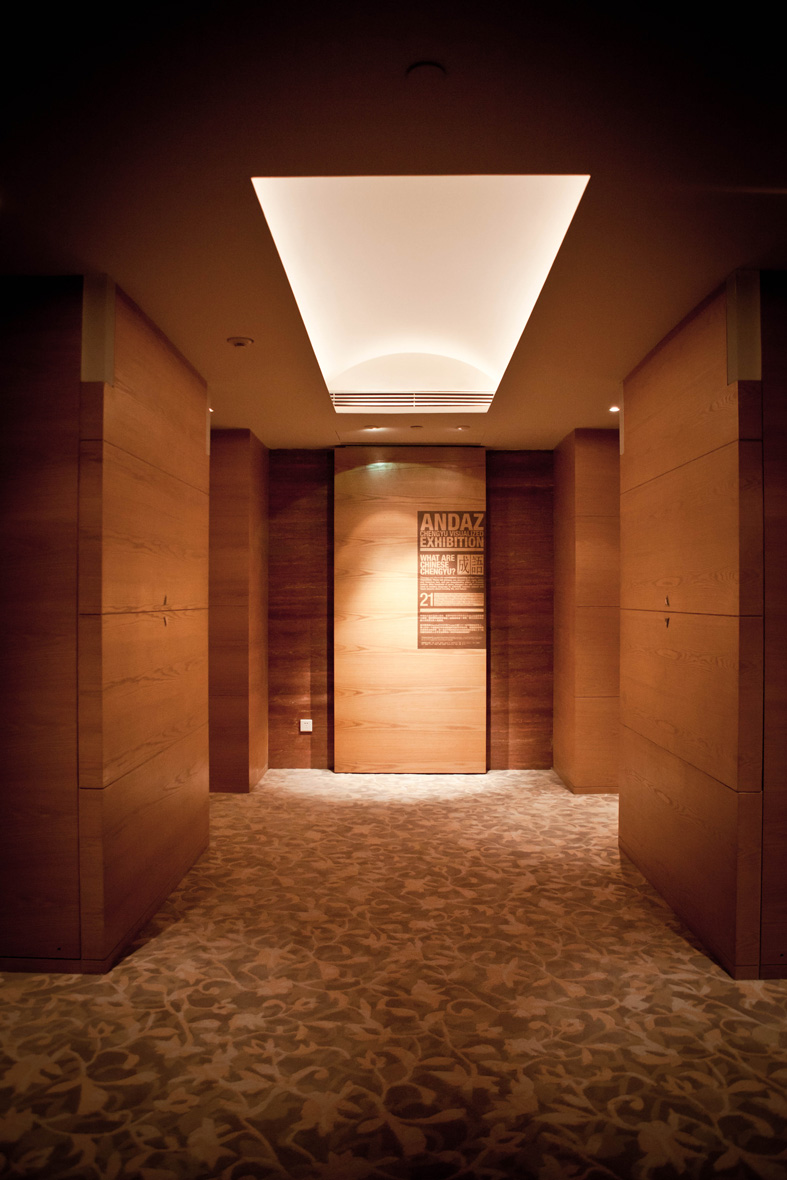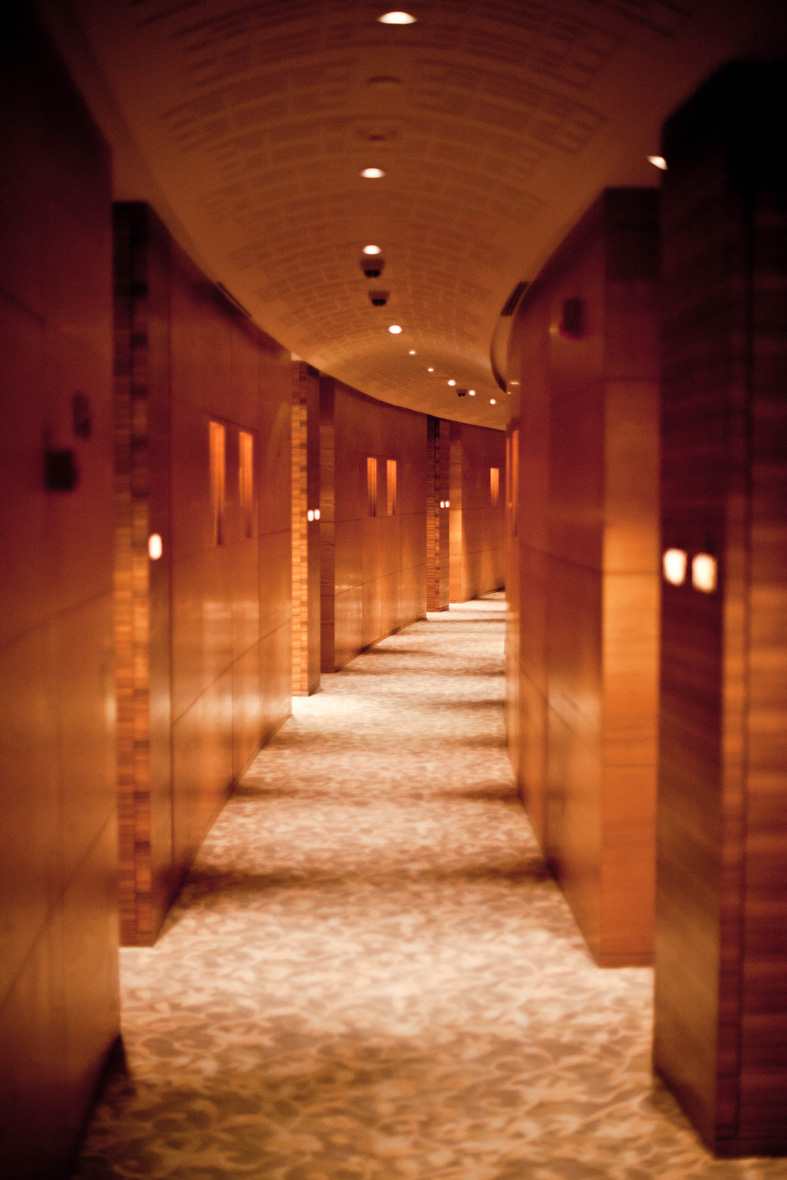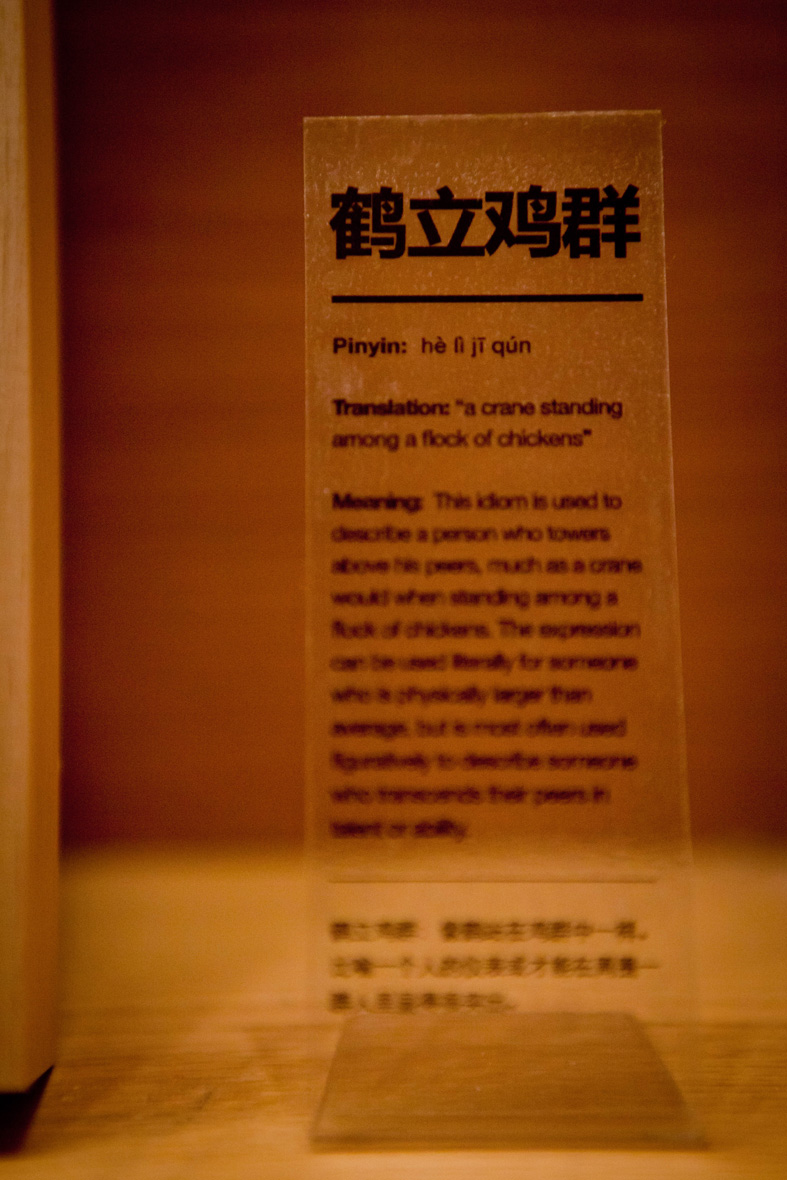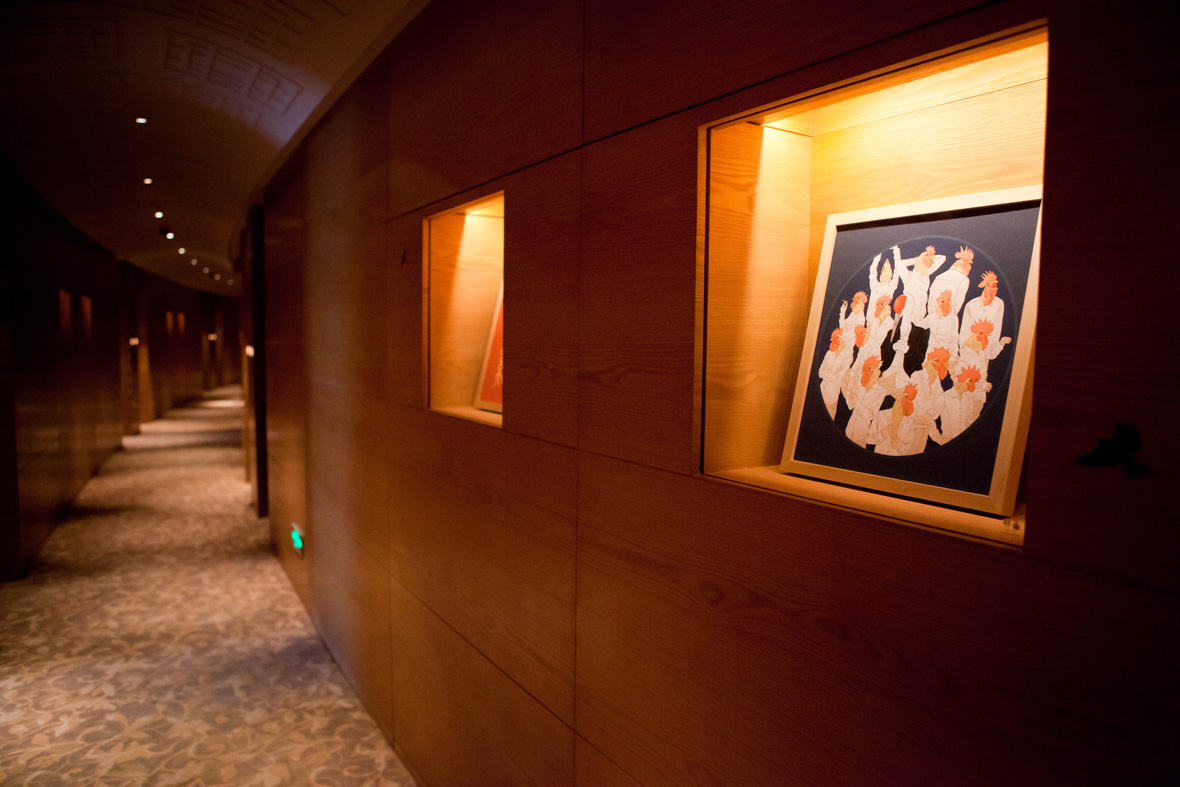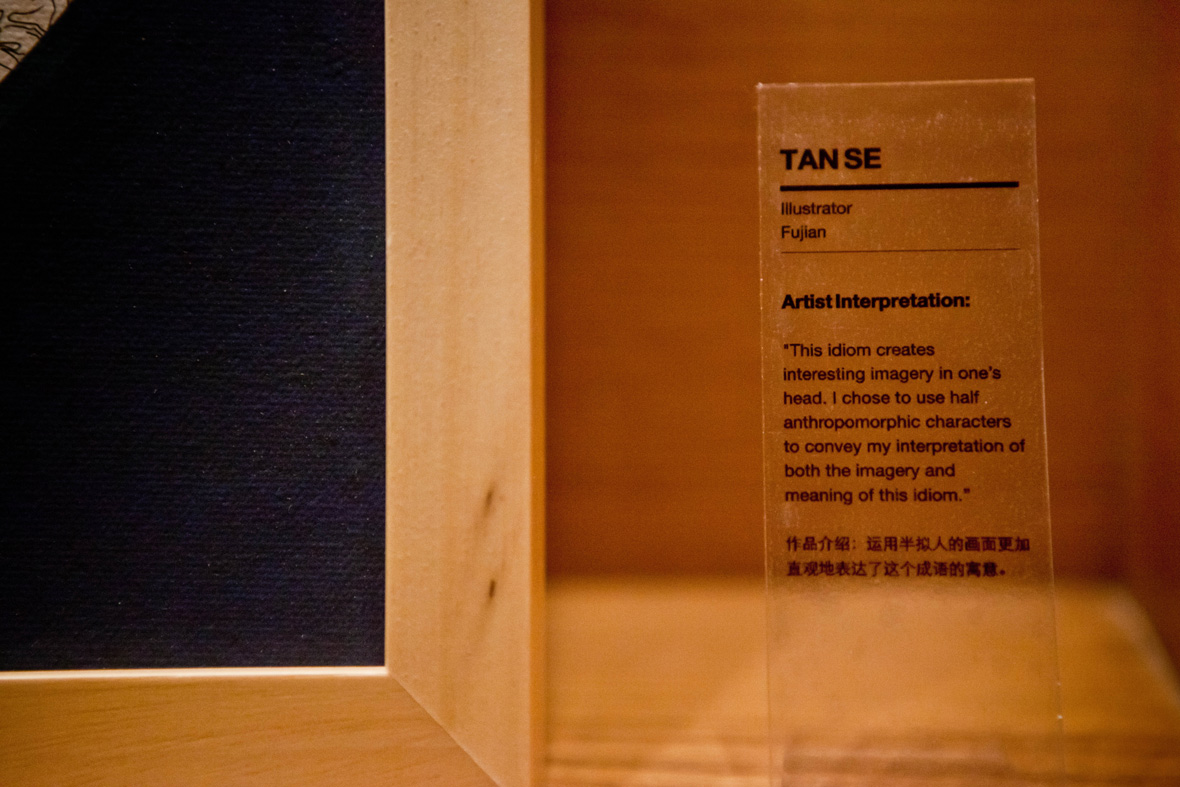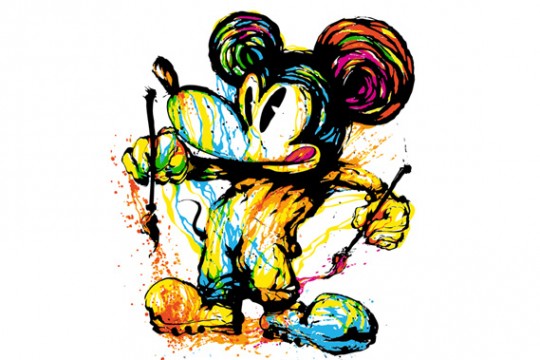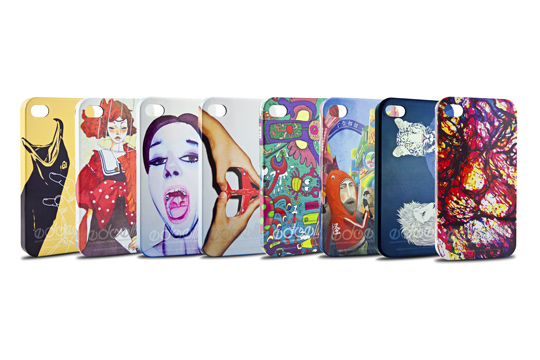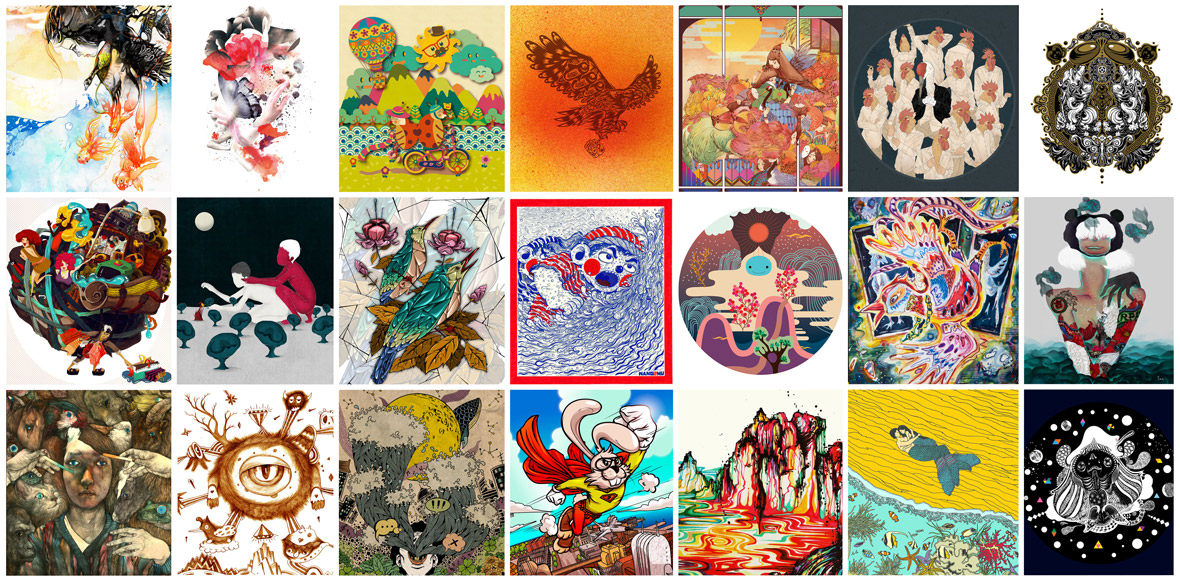
Storytelling takes many forms and idioms are one of the most elegant ways to encapsulate rich stories in just a few words or characters. Those passionate about Chinese culture know “Chengyu” –four character Chinese idioms–are a priceless and colorful source of Chinese myths, folktales, and historical facts that teach lessons about morality, life, and nature.
We’ve always believed that Chengyu should be celebrated more widely and in a variety of styles, including taking a modern approach to the visual reinterpretation of the four characters that make them up and the stories the phrases tell. That’s why we’re proud to announce our collaboration with Osage Art Consultancy to curate and produce an exhibition at Hyatt ANDAZ Shanghai titled “Chengyu Visualized.”
For the exhibition, 21 emerging Chinese artists from all over the country visually interpreted their favorite “chengyu” through typography design and artwork. “Chengyu Visualized” captures the essence of traditional Chinese idioms in a modern way, while showcasing a variety of individual artistic styles through various mediums.
We collaborated with several leading edge Chinese artists: Elephant, Niu Xiaosheng, Lok Ng, Garfield.M, IMKENICAN, Lulu, Mojo, Sally Zou, SO.P, Shrek Su, Hong Hua, Hua Tunan, Coozie, Broken Bike, Mei Lin, Su Sisi, Shadow Chen, Tan Se, Wang Na, Wang2Mu, and Momo.
中国的汉语本就博大精深,而其中富有玩味的成语更是让汉语文化锦上添花,通过凝炼的四字短语(就通常而言)反映、表达出缤纷多彩的人文世界以及人情道理。
一直以来我们都认为成语应该用不同寻常的方式来表现,会别有情趣。很高兴受到上海新天地全新开业的精品酒店ANDAZ的委托,新茶和Osage Art Consultancy合作策划了这次“成语视觉化”的展览。
我们为此邀请了21位来自中国不同城市的创作人针对21个成语进行了一番字体和插画的艺术再创作,用插画向观者传达成语包含的意思,这一饱含中国传统历史文化的成语经过这21位中国年轻创作人之后又会展现怎样的风貌呢?
此次参加创作的艺术家有:大象、牛小盛、Lok Ng、Garfield. M、IMKENICAN、Lulu、MOJO、Sally Zou、SO.P、黑设绘、红花、画图男、Coozie、烂单车、梅林、苏四饲、Shadow Chen、炭色、汪娜、王二木和Momo。
Mei Lin / 柳暗花明
Chengyu – liǔ àn huā míng / 柳暗花明
Literal meaning – “Dense willow trees and bright flowers.” This idiom is often used in times of despair as a mental departure from a difficult situation. It alludes to the beauty of the world and acts as a reminder that there is a light at the end of the tunnel.
Artist interpretation – “This idiom evokes a strong sense of classic and elegant beauty. When it came to font design, I tried to preserve the fundamental style of the character while also smoothing out the lines by adding curves. The illustration uses simple, yet abstract elements to portray poetic scenes of beauty.”
成语 – “liǔ àn huā míng” / 柳暗花明
字面意思 – 比喻由逆境转为充满希望的顺境。
创作解读 – 柳暗花明一直是我很喜欢的成语,它有一种古典优雅的美。在字体设计上,我试图保持基本字形加之流畅的曲线连接,插画运用简单抽象的元素描绘了美好诗意的景致。
Wang2Mu / 逆流而上
Chengyu – nì liú ér shàng / 逆流而上
Literal meaning – “To go against the current.” This idiom is used to describe someone who is willing to break from conformity and is unafraid to try different things.
Artist interpretation – “The emotion captured in this image lies in the man’s facial expression. Through his grimace we see his endurance and perseverance in reaching his goal, while everything around him moves in opposition.”
成语 – “nì liú ér shàng” / 逆流而上
字面意思 – 逆:倒。逆水前进。比喻迎着困难而上。
创作解读 – 画面上的人物逆着流水的方向努力得往上游。
Sally Zou / 珠联璧合
Chengyu – zhū lián bì hé / 珠联璧合
Literal meaning – “Strings of pearls and bands of jade.” This idiom is used to describe things that are a perfect fit for one another; analogous to the round pearls of a necklace fitting flawlessly into the circular jade bands they are coupled with. This phrase is often used to describe a strong marriage between two people or things that work together seamlessly.
Artist interpretation – “I wanted this piece to be a symmetrical composition so as to emphasize the continuity and harmony of the elements. The centerpiece of this illustration is traditional Chinese jade. Surrounding the jade are a variety of precious stones, totems, and pearls that come together cohesively to create this beautiful image.”
成语 – “zhū lián bì hé” / 珠联璧合
字面意思 – 比喻杰出的人才或美好的事物结合在一起。
创作解读 – 璧:中间有孔的玉器。结合各种中国图腾元素和玉雕图案,珍珠联成串,美玉合成双。
Coozie / 口若悬河
Chengyu – kǒu ruò xuán hé / 口若悬河
Literal meaning – “A mouth like a waterfall.” This idiom describes a person who is overly loquacious and tends to babble on.
Artist interpretation – “The powerful currents of water represent an uncontrollable flow of words. The words coming out of the person’s mouth are powerful, but unrefined and aimless.”
成语 – “kǒu ruò xuán hé” / 口若悬河
字面意思 – 讲起话来滔滔不绝,象瀑布不停地奔流倾泻。形容能说会辨,说起来没个完。
创作解读 – 上聊天文 下说地理 他们的话语 如同奔涌的江河。
Imkenican / 鸟语花香
Chengyu – niǎo yǔ huā xiāng / 鸟语花香
Literal meaning – “Bird songs and fragrant flowers.” This idiom describes a beautiful Spring day.
Artist interpretation – “The fine details in the foliage and feathers of the birds are meant to evoke memories of the Spring season, compelling viewers to reminisce about the call of birds and the fragrance of blooming flowers.”
成语 – “niǎo yǔ huā xiāng” / 鸟语花香
字面意思 – 形容春天景色美好。
创作解读 – 画中强硬中带着柔软的线条,加以色块层次的表现法使整个环境中的鸟与花显得更优美,画边的线条加以强调画中的鸟叫得好听,花开得喷香。
Hong Hua / 豆蔻年华
Chengyu – dòu kòu nián huá / 豆蔻年华
Literal meaning – “The cardamom years.” This idiom is used in reference to girls in their early teens, which is widely regarded in Chinese culture as a beautiful and very meaningful age.
Artist interetation – “I wanted to focus on the facial expressions of adolescent girls to reflect the pompous yet innocent attitude they often have at this stage of life. The girls are lost in a bed of beautiful cardamom plants as they bud and continue to grow along side the plants.”
成语 – “dòu kòu nián huá” / 豆蔻年华
字面意思 – 指女子十三四岁时,美好的年纪。
创作解读 – 主要想体现一种繁盛的少女生长姿态,茂密、复杂,带有特定时期浮夸又不确定的情感,采用类似浮世绘装饰画的手法来描绘这样的状态。
Shadow Chen / 沉鱼落雁
Chengyu – chén yú luò yàn / 沉鱼落雁
Literal meaning – “Make fish sink and geese fall from the sky.” This idiom is used to convey the beauty of an extremely attractive woman, implying that her presence is enough to make fish sink and cause geese to fall from the sky in awe of her appearance.
Artist interpretation – “This work is inspired by the wonders of nature and the complexity of human emotion. The beautiful woman in this piece appears to be sad yet tranquil, which reflects her feelings toward her own beauty and the tragic effects it has on the world around her.”
成语 – “chén yú luò yàn” / 沉鱼落雁
字面意思 – 鱼见之沉入水底,雁见之降落沙洲。形容女子容貌美丽。
创作解读 – 画面里的女子为自己的美貌所带来的“鱼沉到水底大雁落下”悲剧结果感到悲伤。
Momo / 蚌病生珠
Chengyu – bàng bìng shēng zhū / 蚌病生珠
Literal meaning – “A sick clam births a pearl.” Clams must first endure the hardship of ingesting gritty sand before they are able to create beautiful pearls. This idiom draws a parallel to people that are forced to deal with adversity throughout their lives. It is through these hardships that they are able to gain a unique perspective on life and their surroundings, and in turn produce some of the world’s most beautiful works.
Artist interpretation – “I chose to use a line drawing method for this piece and incorporated some elements of plane geometry around the clam to represent pearls and other products of its experience. In its lifetime the clam has experienced both tribulation and enlightenment, and it faces it all with a smile.”
成语 – “bàng bìng shēng zhū” / 蚌病生珠
字面意思 – 比喻因不得志而写出好文章来。
创作解读 – 作品用了黑白线描的方法,加入了一些平面几何的元素,画面中间的蚌经历了一番磨难之后,终于开悟了,它脸带笑容。周围的哪些圆形的珍珠和元素,都是它经验后的产物。
Su Sisi / 白鱼赤乌
Chengyu – bái yú chì wū / 白鱼赤乌
Literal meaning – “White fish, red crow.” This idiom is used to describe signs of good fortune.
Artist interpretation – “In traditional Chinese culture, white fish are symbolic of good fortune. The woman featured in this illustration has several tattoos of traditional Chinese totems, including several white fish. Her white fish tattoos bring her good fortune, and with it, she is able to elevate herself above the clouds.”
成语 – “bái yú chì wū” / 白鱼赤乌
字面意思 – 形容祥瑞之兆。
创作解读 – 选择画中出现白色的鱼,因为白色的鱼象征祥瑞之兆。白鱼赤乌这句成语出自南朝,梁,刘勰《文心雕龙·正纬》:“白鱼赤乌之符,黄金紫玉之瑞,事丰奇伟,辞富膏腴。
SO.P / 画龙点睛
Chengyu – huà lóng diǎn jīng / 画龙点睛
Literal meaning – “Bring the painted dragon to life by adding a pupils of its eyes.” This idiom portrays bringing a piece of work to life y adding in intricate details. The expression is often used to describe finishing touches / last steps of a project.
Artist interpretation – “Eyes are the most important element in interpreting emotion and life. They play a pivotal role in helping us understand the world and beings around us. Each individual person’s interpretation of eyes is very different, and by changing unique details in a characters eyes, I’m able to alter the mood of the entire painting.”
成语 – “huà lóng diǎn jīng” / 画龙点睛
字面意思 – 说话或做事关键部位处理得好,使整体效果更加传神。
创作解读 – 成语的趣味在于它可以被随性地定义。“画龙点晴”相比近义的“点睛之笔”,除了“灵性”意味之外更具备主观色彩。“睛”是我们体会世界最主要的媒介,然而它往往会被自己或他人主观的“点”出来,因此我们所体会到的,都会如“画龙”般不同于现实。缺乏主观观察的世界,使字似字,却不完整,需要的便是“画龙点睛”般主观的一笔。
Garfield / 作茧自缚
Chengyu – zuò jiǎn zì fù / 作茧自缚
Literal meaning – “To spin a cocoon around oneself.” This idiom alludes to a person who makes matters more difficult “Eyes are the most important element in interpreting emotion and life. They play a pivotal role in helping us understand the world and beings around us. Each individual person’s interpretation of eyes is very different, and by changing unique details in a characters eyes, I’m able to alter the mood of the entire painting.”
Artist interpretation – “Delicate brushwork, asymmetrical elements, gorgeous colors; these are all things I incorporated into the piece to translate the beauty of life among the chaos of living it. The subject of the painting evokes humor while portraying an interesting view of the human condition.”
成语 – “zuò jiǎn zì fù” / 作茧自缚
字面意思 – 蚕吐丝作茧时,把自己包在里面。比喻人做事原来希望于自己有利,结果却反使自己吃亏受到连累。也比喻自己束缚自己。
创作解读 – 细腻的笔法,不对称的元素,单纯绚丽的颜色,具有动感的构成画面,力图在画面中诙谐而带有趣味性勾勒出的某种生活状态,某种人的状态。为了强调主题中的“自缚”的形象,烘托出这种“失衡”的感受,在画面内容的构架中,瘦弱的主角承载着他背上的巨大的背囊,同时还企图得到更多。运用生活中的各种物质作为一种代表的元素,简单明了的呈现某一种疯狂的生活现象。
Tan Se / 鹤立鸡群
Chengyu – hè lì jī qún / 鹤立鸡群
Literal meaning – “A crane standing among a flock of chickens.” This idiom is used to describe a person who towers above his peers, much as a crane would when standing among a flock of chickens. The expression can be used literally for someone who is physically larger than average, but is most often used figuratively to describe someone who transcends their peers in talent or ability.
Artist interpretation – “This idiom creates interesting imagery in one’s head. I chose to use half anthropomorphic characters to convey my interpretation of both the imagery and meaning of this idiom.”
成语 – “hè lì jī qún” / 鹤立鸡群
字面意思 – 像鹤站在鸡群中一样。比喻一个人的仪表或才能在周围一群人里显得很突出。
创作解读 – 运用半拟人的画面更加直观地表达了这个成语的寓意。
Hua Tunan / 锦绣山河
Chengyu – jǐn xiù shān hé / 锦绣山河
Literal meaning – “A beautiful brocade of mountains and rivers.” This idiom is used to describe the beauty of China’s majestic landscapes, suggesting that the vast mountains and rivers found in China’s countryside are just as beautiful as their depictions in traditional silk embroideries of the past.
Artist interpretation – “I utilized several different materials and techniques to create a traditional landscape painting with a modern twist. I chose to use vibrant colors to make a strong impact that would boldly contradict the monotonous aesthetics of traditional Chinese landscape paintings.”
成语 – “jǐn xiù shān hé” / 锦绣山河
字面意思 – 形容美好的国土。
创作解读 – 以全新的视觉营造传统山水的气势,用颜料做元素,给观者一种视觉上的冲击,颠覆审美上的习惯,从而激发观者的灵感。
Mojo / 掩耳盗铃
Chengyu – yǎn ěr daò líng / 掩耳盗铃
Literal meaning – “To plug one’s ears while stealing a bell.” This idiom is meant to characterize a person that is foolishly blinded by their own self-deception. Such a person would be acting with the same foolishness as a thief trying to steal a bell with his ears plugged; unaware of the attention he is drawing to himself because he has chosen to block out the ringing.
Artist interpretation – “People go to extremes to trick themselves into believing that their delusions could be easier to achieve if they just ignore the obstacles that stand in their way. They remain unaware of the risks and dangers, yet recklessly move forward to entertain their impulses.”
成语 – “yǎn ěr daò líng” / 掩耳盗铃
字面意思 – 偷铃铛怕别人听见而捂住自己的耳朵。比喻自己欺骗自己,明明掩盖不住的事情偏要想法子掩盖。
创作解读 – 有时候人就是会想尽一切办法自己骗自己,以为骗过了自己,假象便能成真,殊不知危机四伏,在他人眼里只是一个自娱自乐的笑话。
Broken Bike / 突飞猛进
Chengyu – tū fēi měng jìn / 突飞猛进
Literal meaning – “To leap and advance boldly.” This idiom is used to describe someone who is able to progress very quickly, advancing by leaps and bounds to a higher level.
Artist interpretation – “In traditional Chinese culture, rabbits are symbolic of speed, much like Superman in modern culture. I drew upon the elements of both the rabbit and Superman to highlight the speed and confidence of someone that is able to make bold advances in life.”
成语 – “tū fēi měng jìn” / 突飞猛进
字面意思 – 用来形容进步的速度很快。
创作解读 – 采用“突”的谐音“兔” 将兔子化身为行动迅速,雷厉风行的超人,通过兔子翱翔天空,速度媲美飞机的英姿,形象地突出“突飞猛进”的主题。
Lok Ng / 非礼勿言
Chengyu – fēi lǐ wù yán / 非礼勿言
Literal meaning – “The impolite must not be said.” This idiom was commonly used in ancient times when Chinese people lived in a very strict hierarchical society. There were many things that people weren’t permitted to say to someone of an older generation or higher social class. This expression is still used today to denote something that is too impolite to say.
Artist interpretation – “The flower and butterfly elements work to establish a sense elegance, while the woman’s facial expressions indicate that she is restraining herself from expressing her thoughts. Her hands work to repress her impolite thoughts, which are represented by the ink splatters that taint the image.”
成语 – “fēi lǐ wù yán” / 非礼勿言
字面意思 – 不合符礼教的话不能说。
创作解读 – 在整体的设计上运用了水彩及水墨的感觉,在纸上绽放出一种优雅的感觉,以花朵和蝴蝶去点缀表现“礼”的美。在画里的出现了两只手分别捂着嘴,预示出没有礼貌的话不能说,不道德的话不能说。背景的墨水预示凡事不礼言相对,必定祸从口。
Niu Xiaosheng / 风和日丽
Chengyu – fēng hé rì lì / 风和日丽
Literal meaning – “Gentle breeze and bright sunshine.” This idiom is used to describe the weather on a beautiful day.
Artist interpretation – “When people see my work, I want them to be able to feel a soft, gentle breeze and the warm summer sun on their face. I utilized a paper cut-out aesthetic, together with refreshing, cutesy colors to capture the warmth and joy of a beautiful sunny day.”
成语 – “fēng hé rì lì” / 风和日丽
字面意思 – 和风习习,阳光灿烂。形容晴朗暖和的天气。
创作解读 – 让看到作品的人的心情像“风和日丽”的天气一样晴朗暖和!作品用了假剪纸投影的效果,清新可爱的颜色诠释了和风习习,阳光灿烂的画面。瓢虫爷爷带着瓢虫奶奶在风和日丽的天气出游,是多么惬意的一件事情啊!
Lulu / 相濡以沫
Chengyu – xiāng rú yǐ mò / 相濡以沫
Literal meaning – “To moisten each other with spit.” This idiom alludes to a Chinese folktale about two beached fish struggling to keep each other alive by using all the fluids they have left in them / around them to moisten each other. The expression is used to implore people to be altruistic in helping one another in times of need, no matter how scarce resources may be and without regard to one’s own well-being.
Artist interpretation – “The use of the black gel pen on white paper outlines the movement of the two mermaids stranded on the beach struggling to make their way back to the ocean. The bottom portion of the piece is meant to provide a stark contrast, showing life in the water thriving as usual.”
成语 – “xiāng rú yǐ mò” / 相濡以沫
字面意思 – 比喻一同在困难的处境里,用微薄的力量互相帮助,只为了保住生命。多用来形容夫妻间的感情。
创作解读 – 运用黑色中性笔在白纸上自由勾勒出唯美动人的画面,相恋的人鱼在沙滩上彼此鼓励,相互扶持,抵抗骄阳,期待着生命延续的奇迹发生。画面下方渲染出欢乐的家园景象,更加反衬出人鱼此时此刻的困难处境。PS里将线条附着上鲜明的色块,于是那个古老动人的传说便如童话般呈现在我们眼前。
Shrek Su (aka: 黑设绘) / 见怪不怪
Chengyu – jiàn guài bù guài / 见怪不怪
Literal meaning – “To see the unfamiliar and not express dismay.” This idiom is used to describe a person’s poise and tranquility in an otherwise strange and unfamiliar situation.
Artist interpretation – “The small monsters that surround the cyclops are the creatures that haunt him. If we can understand that everyone and everything has something they are afraid of, it can help us keep an open mind about the strange and unknown, and teach us not to fear the unfamiliar.“
成语 – “jiàn guài bù guài” / 见怪不怪
字面意思 – 发现怪事怪物不要惊慌,它就不会危害了。
创作解读 – 你见到的怪物是真实的,你梦到的也是真是的,你走进去了才能发现原来怪物是那么多。运用黑白素描的表现方式,这样制作起来很有成就感。画面的构成上,我采用了一只大大的眼球怪物,犀利的眼神看着周围的一切,当然你也见到了他,所以都那么顺其自然吧,部要大惊小怪,要见怪不怪,回头就当做这一切都没发生吧。
Wang Na / 山鸡舞镜
Chengyu – shān jī wǔ jìng / 山鸡舞镜
Literal meaning – “A pheasant dancing in front of a mirror.” This idiom refers to a story in which a pheasant becomes obsessed with her own reflection while dancing in front of a mirror and ultimately dances herself to death. The expression is meant to be a reminder that narcissism is not healthy, and that one should not over-indulge in self-admiration.
Artist interpretation – “I used watercolor as a medium for this painting as it allows for more freedom in creating unrestrained lines. This flexibility enabled me to accurately illustrate the reserved appearance of the pheasant, while simultaneously creating a dynamic dance scene.”
成语 – “shān jī wǔ jìng” / 山鸡舞镜
字面意思 – 比喻顾影自怜,自鸣得意。
创作解读 – 运用水彩这种媒介,更自由洒脱得在纸上画下笔触色块,表现山鸡矜持自己的美貌并热舞的情景,松动的笔触烘托这种活力的气氛,背景画了一些虚幻的魔鬼头像,预示出了山鸡固执于自己的美貌最后却舞蹈到死亡的后果。
Elephant / 鸿鹄之志
Chengyu – hóng hú zhī zhì / 鸿鹄之志
Literal meaning – “A swan’s ambition.” This idiom is used to describe a person with great aspirations.
Artist interpretation – “I wanted to create a contrast in this piece by illustrating an eagle in an aggressive attack position carrying a rose. This contrast of fierce aggressiveness and romanticism implies that a person’s ambitions may not always be as savage as the actions and attitude one must assume to achieve those goals.”
成语 – “hóng hú zhī zhì” / 鸿鹄之志
字面意思 – 形容志向远大。
创作解读 – 浪漫的威慑性格分裂。慑人的爪子叼着的不是死体而是浪漫的玫瑰,在天空翱翔的雄鹰想要向人传达的是有时候用更温柔点的方式也可以完成远大的志向。











































